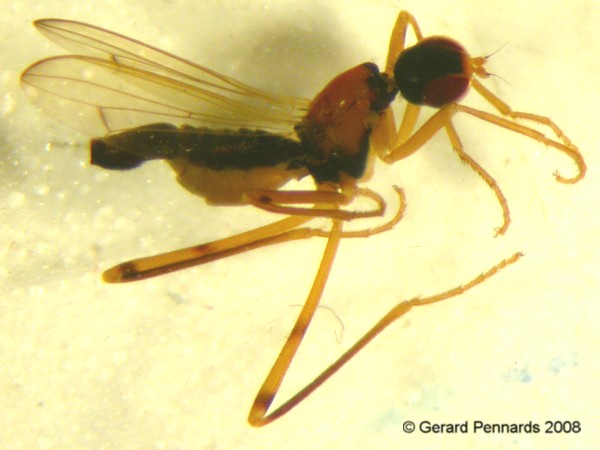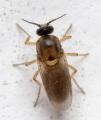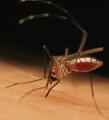Diptera.info :: Identification queries :: Diptera (adults)
|
Neria octoannulata???
|
|
| Gerard Pennards |
Posted on 17-08-2008 15:13
|
|
Member Location: Amersfoort Posts: 1914 Joined: 07.06.04 |
This Micropezid was caught in the Netherlands in May. Is it Micropeza lateralis? Greetings Gerard Pennards attached the following image:  [53.28Kb] Edited by Gerard Pennards on 21-08-2008 10:36 Greetings, Gerard Pennards |
|
|
|
| jorgemotalmeida |
Posted on 17-08-2008 17:38
|
|
Member Location: Viseu - PORTUGAL Posts: 9296 Joined: 05.06.06 |
~I only have sure for Micropeza. M. lateralis with more light fore tibia (yellow) and mesonotum with two yellow stripes. M.grallatrix with blackish fore tibia and without yellow stripes. Fore tibia is light.. not dark... and there are no stripes on mesonotum in your specimen. Maybe some variation of M. lateralis? or another species. |
| Gerard Pennards |
Posted on 17-08-2008 18:36
|
|
Member Location: Amersfoort Posts: 1914 Joined: 07.06.04 |
Well, I know some of you think it should be Neria ephippium. It indeed looks like it, but in the key I use the difference between Micropeza and Neria lies in the presence or absence of crossvein BM-Cu. In this animal there is no crossvein Bm-Cu, so it should be a Micropeza. In N. ephippium the katepisternumbetween coxa 1 and 2 should be yellow/ white, in this animal it's black. And the only Micropeza I know which doesn't have a black thorax is lateralis. So hence my idea of it being a Micropeza lateralis female! Greetings Edited by Gerard Pennards on 17-08-2008 18:37 Greetings, Gerard Pennards |
|
|
|
| Gerard Pennards |
Posted on 19-08-2008 09:59
|
|
Member Location: Amersfoort Posts: 1914 Joined: 07.06.04 |
I got this answer from Andrey Ozerov: Dear Gerard. Thanks for your message. Neria octoannulata (Strobl, 1899) is fly on foto. Not Micropeza, the species of this genus has row of setae on mid and hind tibiae dorsally. If so, it would be a new species for the Netherlands!!!!    Which would be great, naturally. Greetings, Gerard Greetings, Gerard Pennards |
|
|
|
| jorgemotalmeida |
Posted on 19-08-2008 12:30
|
|
Member Location: Viseu - PORTUGAL Posts: 9296 Joined: 05.06.06 |
 better not talking about micropezidae during a long time. better not talking about micropezidae during a long time.  |
| Paul Beuk |
Posted on 21-08-2008 08:48
|
|
Super Administrator Location: Netherlands Posts: 19403 Joined: 11.05.04 |
If the characters given by Hennig (1936) (PDF) are correct, then this is just the 'regular' ephippium: only femora 3 with two dark rings (contrary to femora 2 and 3 with two black rings) and meso- and pteropleura rusty brown-red (blackish in octoannulata).
Edited by Paul Beuk on 21-08-2008 08:56 Paul - - - - Paul Beuk on https://diptera.info |
| Nosferatumyia |
Posted on 21-08-2008 09:36
|
|
Member Location: Posts: 3524 Joined: 28.12.07 |
I'd rely on Ozerov's opinion: he's the only expert who closely examined or revised PA micropezids nowadays, however keeping in mind several cases of my own misIDs based on pickxs only, I'd better suggest to check it over and over again... The Netherlands and Sierra Nevada are not the same thing, and the find of N. octoannulata here looks very suspicious.
Val |
|
|
|
| Gerard Pennards |
Posted on 21-08-2008 10:42
|
|
Member Location: Amersfoort Posts: 1914 Joined: 07.06.04 |
Dear Valery, Yes, it's true, I had send Anrey the picture because the animal has a strange feature in the wing, there should be a crossvein BM-Cu to belong to the Neria's, but it hasn't! So with my keys it came to genus Micropeza. Now I'm sure it's a Neria (with that missing vein as an aberration), but I had expected N. ephippium, and not octoannulata, which is only recorded from Spain. Today I re-examined the specimen with Paul Beuk, and we think it's ephippium!! I've send Andrey an email for confirmation, but until now no answer. Tonight I'll make some more detailed pictures of the fly and send them to him... Greetings, Gerard Greetings, Gerard Pennards |
|
|
|
| Gerard Pennards |
Posted on 31-08-2008 21:48
|
|
Member Location: Amersfoort Posts: 1914 Joined: 07.06.04 |
After some correspondence with Andrey, I got the following answer: Dear Gerald, Many thanks for your message and new photos (it is very important for diagnostic) which proved to be very useful. I returned to Moscow on Friday and was in Zoological museum where I studied the material on N. ephippium and N.octoannulata.Your specimen and specimens of N.octoannulata have strongly darkened (black) proepisternum though all the specimens of N. ephippium in our Museum have yellow proepisternum. However now I have refused this character and think that the coloration of proepisterna may vary. N. ephippium has the darkening along costa near wing apex. Your specimen has the same, it is seen clearly. The wing of N.octoannulata is without darkenings. Besides the pollen on proepisternum of N. octoannulata is thicker then in N. ephippium and your specimen.I think that your specimen is female of Neria EPHIPPIUM (freak with reduced bm-cu vein). With best wishes, Andrey Thanks very much Andrey!! So, unfortunately not a new species for the netherlands.....   Greetings, Gerard Greetings, Gerard Pennards |
|
|
|
| Jump to Forum: |













